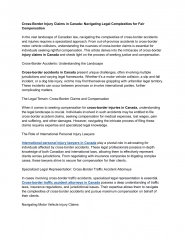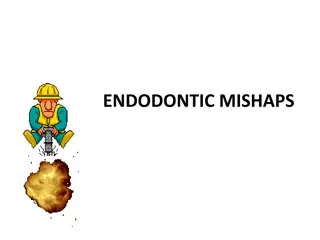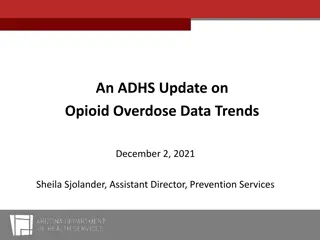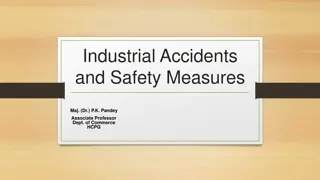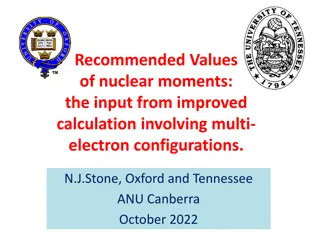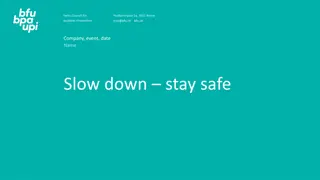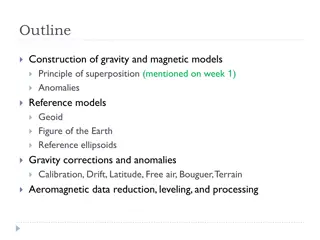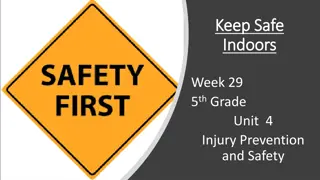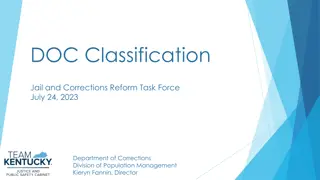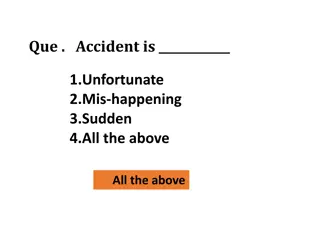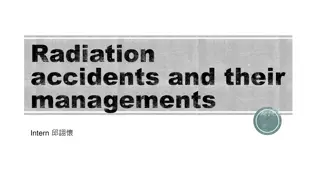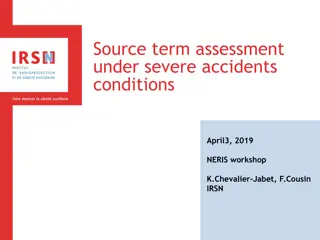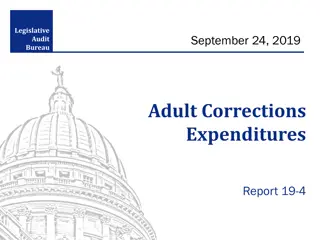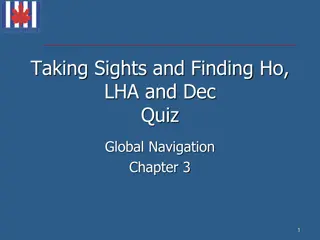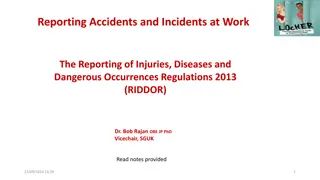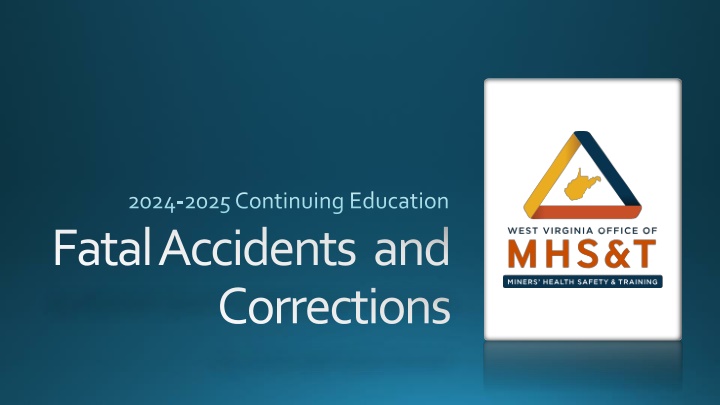
Preventing Fatal Accidents in Mines: Lessons Learned and Safety Measures
Learn from a tragic fatality in a Pennsylvania mine, where a miner was fatally injured due to adverse roof conditions. The incident highlights the importance of proactive safety measures, proper roof control plans, and effective support systems to prevent accidents. Explore the details of the accident, including the location, roof control plan, and support measures implemented. Reflect on the incident to enhance safety protocols and prevent similar tragedies in mining operations.
Download Presentation

Please find below an Image/Link to download the presentation.
The content on the website is provided AS IS for your information and personal use only. It may not be sold, licensed, or shared on other websites without obtaining consent from the author. If you encounter any issues during the download, it is possible that the publisher has removed the file from their server.
You are allowed to download the files provided on this website for personal or commercial use, subject to the condition that they are used lawfully. All files are the property of their respective owners.
The content on the website is provided AS IS for your information and personal use only. It may not be sold, licensed, or shared on other websites without obtaining consent from the author.
E N D
Presentation Transcript
2024-2025 Continuing Education Fatal Accidents and Corrections
Fatal Accidents & Review As you proceed through these fatals, ask yourself What would I do on my section or at my mine to avoid these types of fatals? . We, as foremen, need to be proactive instead of reactive. Have you had any near misses that you did nothing about? Did you have safety meetings about it and changed your procedures or any other proactive measures? What would you have done in these situations? Let s go over the fatals and discuss them!
March 2, 2022 Fatality Location: Somerset Pennsylvania MINE FATALITY On March 2, 2022, a miner was fatally injured when an overhang along the mine rib fell, striking the miner and pushing him against the canopy of a twin boom roof bolting machine. The miner freed himself from the fall, but later died.
Location of Accident The accident occurred in the Main A Section, in the No. 5 entry, approximately 210 feet from the working face on the corner of the coal pillar between the No. 4 and No. 5 entries (see Appendix B). The No. 5 entry was mined approximately 18 feet wide, and the depth of cover was about 400 feet at the accident site. Adverse roof conditions were encountered when the accident site was originally mined, approximately two weeks before the accident occurred (more details regarding the adverse roof are presented below in the Geology section). The area of loose roof had been removed with a CMM, as was a standard practice at Maple Springs Mine according to interviews. The resulting mining height was 4.5-5.5 feet including 1.5-2 feet of roof rock. The removal of the adverse roof resulted in a slightly arched entry profile, which in turn created a rock brow that was not rectangular or stair-stepped like a typical rock brow, but instead was angled at about 45 degrees from the top of the coal rib to the flat roof (see Appendix C). The rock brow fell when an unseen vertical tension fracture developed at the back of this rock brow above the coal rib line. Investigators estimated that the rock brow measured 52 inches long, 24 inches wide, and 18 to 24 inches thick.
Roof Control Plan and Support The approved roof control plan states that in areas of adverse roof conditions, where a slip, cutter, clay vein, or faults are visible, the minimum length of roof bolt will be six feet. These roof bolts will be used in conjunction with either: 1.Channels, straps or cross bars, 2.Reduced roof bolt spacing, 3.Larger roof bolt bearing plates, or 4.Cable bolts anchored in a minimum of two feet of competent material. Prior to the accident, the mine operator recognized the sub-normal roof conditions and was installing longer primary support with T-3 channels throughout the Section and 12-foot cable bolts in accordance with the roof control plan. The approved plan did not have any provisions for supporting or removing rock brows.
CONCLUSION On March 2, 2022, at approximately 11:00 a.m., a 44 year-old scoop operator with approximately 15 years of mining experience, was fatally injured when a when a rock brow (overhanging rock from the pillar rib) fell and struck him. At the time of the accident, Springer was standing between a roof bolting machine and the mine rib.
ROOT CAUSE ANALYSIS The accident investigation team conducted an analysis to identify the underlying causes of the accident. The team identified the following root cause, and the mine operator implemented the corresponding corrective action to prevent a recurrence. Root Cause: The mine operator was unable to detect the hazard presented by the rock brow due to its shape and lack of visible cracks or separations. Corrective Action: The mine operator trained all miners to identify this specific type of rock brow. The mine operator proposed, and MSHA approved, an amendment to their roof control plan that addresses adequately supporting ribs and rock brows in areas that have loose material in the roof due to adverse roof and rib conditions. When rock brows are encountered during mining they will be removed, if possible. If a rock brow cannot be removed, it will be secured during the roof bolting cycle. The roof bolters will be informed of the rock brow before they enter the cut. If it cannot be supported, the rock brow will be dangered-off immediately and recorded by the end of the shift. The mine operator trained all miners on this amendment to their roof control plan.
Best Practices Remove overhangs with the continuous mining machine. Install support of proper length with surface area coverage, on cycle, and in a consistent pattern for the best protection against falls. Examine the roof, face, and ribs immediately before starting work in an area where people work and travel, including sound and vibration testing, where applicable. Scale loose roof and ribs from a safe location. Prevent access to hazardous areas until you take corrective measures. Take additional safety precautions when encountering new and changing roof and rib conditions. Train miners on how to identify hazardous roof and rib conditions.
February 28, 2022 Fatality MINE FATALITY On February 28, 2022, a contract miner died when he was crushed between the rib and a single boom face drill. The victim was alongside the drill using the onboard tram lever controls when the accident occurred because the remote control was inoperable. Location: McDowell, West Virginia
DISCUSSION Location of the Accident The accident occurred at the No. 70 crosscut (Survey Station No. 519) of the intake air course/primary escapeway (see Appendix C). Equipment Involved The drill involved in the accident was a Fletcher Model 3411RE, single boom face drill. The drill does not have an operator s compartment. The drill is equipped with a wireless remote controller and onboard tram control levers located near the center on the right side of the machine. The mine operator employed a contract company to operate the drill, for internal slope development, beginning in March 2021. During the final slope work in December 2021, the contractor used both the remote controller and onboard controls to operate the drill. When the slope project was completed, the contractor parked the drill in the No. 120 crosscut. On February 28, 2022, investigators observed the remote controller stored in an opening on the rear of the drill. It was not being used at the time of the accident due to discharged batteries. Since the remote controller would not operate the drill with discharged batteries, investigators determined that there was no safe way to move the drill to conduct functional tests. At this time, the mine operator locked and tagged the drill out of service until the manufacturer representative could make the necessary repairs to the remote controller on March 1, 2022.
DISCUSSION During the examination of the drill, when using the remote controller, all functions operated properly. When the drill s operational control was switched from remote operation to manual operation, the right-side crawler track began tramming upon startup. The drill was immediately shut down for examination. While examining the onboard tram lever controls, investigators observed the right-side crawler track lever not centering to the neutral position when released. When the lever was manually centered in the neutral position, the drill began tramming immediately upon startup. When operating properly, the tram control levers will automatically center and return to the neutral position when released, stopping the crawler tracks. The mine operator removed the hydraulic valve assembly from the drill, including the left-side and right-side tram control levers. Investigators determined that the lever being out of adjustment contributed to the accident. The right-side tram controls were out of adjustment, which caused the drill to tram towards the coal rib, thereby crushing the victim between the coal rib and the drill.
CONCLUSION On February 28, 2022, at approximately 5:00 a.m., a 52 year-old project manager with approximately 20 years of mining experience, died when he was crushed between a coal rib and a single boom face drill (drill). Hively was walking alongside the drill, using the onboard tram lever controls when the accident occurred. The accident occurred because the mine operator did not: 1) maintain the drill in safe operating condition, and 2) conduct an examination of the drill before placing it in service.
ROOT CAUSE ANALYSIS The accident investigation team conducted an analysis to identify the underlying causes of the accident. The team identified the following root causes, and the mine operator implemented the corresponding corrective actions to prevent a recurrence. 1.Root Cause: The mine operator did not maintain the drill in safe operating condition. Corrective Action: The mine operator employed a manufacturer Service Technician to replace and properly adjust the onboard tram control levers. The mine operator revised their training plan to include the use of the manufacturer s operator manual and retrained all electrical examiners to assure the drill is maintained in safe operating condition. 2.Root Cause: The mine operator did not conduct an electrical examination of the drill before placing it in service. 3.Corrective Action: The mine operator conducted a complete electrical examination of the drill. The examination has been recorded. The mine operator provided additional training to all electrical examiners to assure adequate electrical examinations are conducted.
Best Practices Mobile equipment shall be maintained in safe operating condition. Immediately remove mobile equipment in unsafe condition from service. Always operate mobile equipment from a safe location. Use the remote control or operate from within the operator s compartment if available. Determine the proper working position to avoid pinch points and Red Zone areas. Train miners on the safety aspects and safe operating procedures of mobile equipment before use. Review and discuss pinch points and Red Zone locations
June 2, 2021 Fatality Location: Marion, West Virginia MINE FATALITY On June 2, 2021, a 26-year- old section foreman with five years of mining experience was pinned against a continuous mining machine by a piece of rib. The piece fell while he was installing a rib bolt with the machine mounted rib drill.
DISCUSSION Location of the Accident The accident occurred at the inby left corner of the No. 6 entry intersection and the 51-block crosscut on the 9-North Mains section. The crack in the rib was approximately two feet from the rib corner where drilling was being conducted. The size of the rib measured approximately six feet long, four and half feet wide, and two feet thick. Normal mining height on this section is approximately 96 inches. The mining height at the accident scene measured 112 inches and consisted of approximately 92 inches of coal and 20 inches of rock binder near the roof line. The mine operator developed the entries with additional height to decrease resistance and improve future airflow to the shaft located in the No. 5 entry (see Appendix D). The immediate strata above the coal seam consists of a gray shale, which includes a rock binder of varying thickness. The coal ribs are prone to sloughage (material that has crumbled and fallen away from the rib) due to the naturally occurring joints and cleats, the softness of the coal, and the depth of overburden. The direction of the 9-North Mains development results in rib sloughage predominately in the crosscuts. This sloughage typically first occurs at rib corners. The overburden at the accident scene is approximately 1,270 feet. The 112-inch mining height and the approximately 1,270 feet of overburden at the accident scene also contributed to the rib sloughage. Investigators determined that between the time that the rib corner was created and the rib bolt installation was first attempted, the factors listed above acted on the rib corner and contributed to the rib failure while attempting to drill and bolt the rib.
CONCLUSION On Wednesday, June 2, 2021, at approximately 2:10 a.m., a 25-year-old section foreman, died when a portion of the mine rib sheared off and pinned him against a continuous mining machine while he was attempting to install a rib bolt. The accident occurred because the mine operator: 1) did not perform an adequate evaluation of the hazardous rib conditions to determine the safest corrective action; and 2) did not have effective policies or procedures to adequately support or otherwise control mine rib corners before the continuous mining machine had advanced enough to install rib bolts.
ROOT CAUSE ANALYSIS The accident investigation team conducted an analysis to identify the underlying causes of the accident. The team identified the following root causes, and the mine operator implemented the corresponding corrective actions to prevent a recurrence. 1.Root Cause: The mine operator did not perform an adequate evaluation of the changing rib conditions to determine the safest action to correct the hazard. Corrective Action: The mine operator modified their written training materials to include the various corrective actions available to address hazardous rib conditions. The mine operator trained all affected miners in scaling methods, bolting techniques, and machine capabilities for correcting hazardous rib conditions. In addition, evaluating the location, type of rib hazard, and correct body positioning to limit exposure was also included in the training. 1.Root Cause: The mine operator did not have effective policies or procedures to adequately support or control the mine rib corners before the continuous mining machine had advanced enough to install rib bolts. Corrective Action: The mine operator developed new policies and procedures and revised the roof control plan to install two additional rib bolts in the upper portion of ribs to support locations that will become rib corners. In areas where the mine operator cannot install additional rib bolts, the mine operator will cut the rib corners before the miners are exposed to the corner.
Best Practices Support loose roof and rib material adequately or scale loose material from a safe location before working or traveling in an area. Examine the roof, face and ribs immediately before starting work in an area and throughout the shift as conditions warrant. Take additional safety precautions when mining heights increase and in areas where mine conditions change. Train miners to recognize roof and rib hazards and to stop work in the area until the hazards are corrected.
May 14, 2021 Fatality Location: Jefferson, Pennsylvania MINE FATALITY On May 14, 2021, a continuous mining machine operator was fatally injured when a piece of rock fell from the roof and struck him. The victim was working under unsupported roof in the Number 1 entry.
DISCUSSION Location of Accident The accident occurred in the D-2 Butt section of the mine. The immediate roof in this area has a bed of clay and silt shale (black draw rock) approximately ten inches to twelve inches thick. The main mine roof above the immediate roof was black silt stone, 38 to 40 feet thick. The entry was approximately 19.5 feet wide, 42 inches high, and relatively dry. The section of roof that fell on the victim was triangular, approximately twelve feet long by nine feet wide, and three to five inches thick. Equipment Involved At the time of the accident, the victim was operating an Eimco Dash Zero CMM. The CMM loaded coal on the No. 1 bridge conveyor, which transported coal through a series of mobile bridge carriers (MBCs) and additional bridge conveyors to the section belt conveyor. The CMM, bridge conveyors, and MBCs are connected and move in tandem. Investigators examined the CMM, bridge conveyors, and MBCs and found no deficiencies. Practice of Exceeding the Maximum Cut Depth The mine operator engaged in a practice of violating the depth of cut requirements in the approved ventilation plan and the approved roof control plan. The approved roof control plan states that the maximum depth of cut, beyond the last row of permanent roof support, is 30 feet. Investigators measured the depth of the cut in the No. 1 entry to be 60 feet. The victim had traveled approximately four feet inby permanent roof support (roof bolts) when he was struck by the fallen rock. The length of the CMM is 26 feet. Therefore, the maximum cut depth is indicated when the bumper of the CMM is four feet inby the last row of bolts. If the bumper of the CMM is more than four feet inby the last row of bolts, the cut depth is greater than 30 feet.
CONCLUSION On May 14, 2021, at approximately 12:45 p.m., 32-year-old continuous mining machine operator with approximately 11 years of mining experience, died when a portion of the mine roof fell on him. The accident occurred as he was operating the continuous mining machine (CMM) by remote control while he was under unsupported roof. The accident occurred because the mine operator: 1) had a practice of exceeding the maximum depth of cut requirements specified in the approved roof control and ventilation plans, 2) did not install unsupported roof warning signs or streamers, and 3) allowed the CMM operator to travel and work under unsupported roof
ROOT CAUSE ANALYSIS The accident investigation team conducted an analysis to identify the underlying cause of the accident. The team identified several root causes, and the mine operator implemented the corresponding corrective actions to prevent a recurrence. Root Causes: The mine operator 1) had a practice of exceeding the maximum depth of cut requirements specified in the approved roof control and ventilation plans, 2) did not install unsupported roof warning signs or streamers, and 3) allowed the CMM operator to travel and work under unsupported roof. Corrective Actions: The mine operator retrained all supervisors and miners on the hazards of mining beyond the allowed depth of cut, the hazards of working and traveling into areas of unsupported roof, and how to properly hang warning signs and streamers to identify areas of unsupported roof.
Best Practices Never work or travel under unsupported roof. Thoroughly examine the roof, face and ribs where people will be working and traveling, including sound and vibration testing. Scale loose roof and ribs from a safe location. Prevent access to unsupported and hazardous areas until appropriate corrective measures can be taken. Follow the approved roof control plan and provide additional support when cracks or other abnormalities are detected. Never exceed the maximum cut depth specified in the approved roof control plan. Mark the second to last row of bolts with reflective material and train miners not to travel inby this location. Train miners to identify hazards from the roof, face and ribs.
September 1, 2022 Fatality Location: Kanawha, West Virginia MINE FATALITY On September 1, 2022, a roof bolter was electrocuted when he contacted a metal hook that became energized after it penetrated the 480-volt cable that supplied electrical power to a roof bolting machine.
DISCUSSION Equipment Involved The No. 709 locomotive involved in the accident was a Brookville 12-Ton Locomotive Model 1260B. Investigators tested the No. 709 locomotive and found no defects that contributed to the accident. The roof bolting machine involved in the accident was a Fletcher DDR-13-A Roof Bolter. Investigators tested the roof bolting machine and found no defects that contributed to the accident. The trailing cable supplying power to the roof bolting machine was a Tiger Brand No. 2 GGC 480-Volt Cable. Investigators examined all 700 feet of the trailing cable and found no other damaged areas besides that caused by the metal S-hook. The metal S-hook punctured the trailing cable s outer jacket and inner conductor insulation of the red phase lead, which contributed to the accident (see Appendix C). Cable pull straps were available for use at the time of the accident, however, these straps were not used. Investigators determined that the red phase lead was energized with 290 volts, phase to ground (voltage measured between a phase lead and the neutral ground), at the time of the accident. Investigators also tested the entirety of the electrical circuit, originating at the No. 2 belt line power center through the No. 3 distribution box to the No. 6 distribution box, which was powering the roof bolting machine. They found no defects in the electrical circuit that contributed to the accident.
CONCLUSION On September 1, 2022, at approximately 4:40 p.m., a 33 year- old roof bolter with approximately 12 years of mining experience, was fatally injured when he contacted an energized 480-volt trailing cable. The accident occurred because the mine operator did not: 1) fully protect the roof bolting machine s trailing cable, and 2) provide adequate task training for handling the roof bolting machine s trailing cable.
ROOT CAUSE ANAYLISIS The accident investigation team conducted an analysis to identify the underlying causes of the accident. The team identified the following root causes, and the mine operator implemented the corresponding corrective actions to prevent a recurrence. 1. Root Cause: The accident occurred because the mine operator did not fully protect the roof bolting machine s trailing cable. Corrective Action: The mine operator developed and implemented a new written procedure for pulling trailing cables with a more suitable type of non-metallic pull rope, such as a cable pull strap, which fully protects the cable. The mine operator trained all miners on this new procedure. 2. Root Cause: The mine operator did not provide adequate task training for handling the roof bolting machine s trailing cable. Corrective Action: The mine operator revised their training plan to include the new written procedure for pulling trailing cables and will provide this training to all miners before they handle energized cables
Best Practices Make sure miners use suitable, non-conductive ropes when pulling or handling electrical cables. Never attach conductive parts, such as metallic hooks, to the portions of non-conductive ropes that contact electrical cables. Make sure miners use proper Personal Protective Equipment when handling cables, such as insulated gloves
March 20, 2022 Fatality Location: Harlan, Kentucky MINE FATALITY On March 20, 2022, a 33 year-old miner died when he was struck by a roof fall while moving a waterline outby the retreat mining section. The intersection of the fall area was supported with five-foot fully grouted roof bolts and 10-foot cable bolts. The roof fall was approximately 40 feet long, 18 feet wide, and five feet thick
DISCUSSION Location of the Accident The accident occurred in the intersection of #8 entry, crosscut #47, on the 3 South Mains, approximately 180 feet outby the retreat mining section, in an area that was not projected for retreat mining (see Appendix B and C). Roof Control Plan and Support The immediate roof (layer of roof immediately above the mined area) of the fall area was five feet thick and consisted of slickensided (compressed to form a slick surface) and laminated shale with coal and slickensided and laminated shale with a two-inch thick coal rider below a massive layer of sandstone. The roof fell up to the beginning of the sandstone where the coal rider created a weak plane. When the 3 South Mains were advance mined (initially mined leaving pillars to support the overburden) in 2017, the mine operator bolted the area with five-foot fully grouted resin bolts on four-foot centers and supplemented the support with ten-foot cable bolts, in accordance with the approved Roof Control Plan (see Appendix D). The five-foot resin bolts did not anchor into the sandstone and relied on the ten-foot cable bolts for anchorage. On March 17, 2022, before the accident, the mine operator began retreat mining and anticipated the need for supplemental roof support in the #1 through #7 entries in the 3 South Mains due to the additional stress on the roof caused by retreat mining in those entries. According to interviews and investigator observations, the mine operator directed miners to install additional ten-foot cable bolts in the #1 through #7 entries in the 3 South Mains.
CONCLUSION On March 20, 2022, at approximately 11:00 p.m, a 33 year-old roof bolter with 13 years of mining experience, died when he was crushed by a roof fall while moving a waterline. The accident occurred because the mine operator did not: 1) conduct a supplemental examination in the #8 entry of the 3 South Mains to identify and correct hazardous conditions prior to miners entering the #8 entry where work was to be performed, and 2) adequately support or otherwise control the roof where miners were required to work or travel in the #8 entry of the 3 South Mains.
ROOT CAUSE ANALYSIS The accident investigation team conducted an analysis to identify the underlying causes of the accident. The team identified the following root causes, and the mine operator implemented the corresponding corrective actions to prevent a recurrence. 1.Root Cause: The mine operator did not conduct a supplemental examination to identify and correct hazardous conditions prior to miners entering the #8 entry of the 3 South Mains where work was to be performed. Corrective Action: The mine operator provided additional training to all mine examiners on the requirements of 75.361, specifically regarding when and how to conduct supplemental examinations. 2.Root Cause: The mine operator did not adequately support or otherwise control the roof where miners were required to work or travel. Corrective Action: The mine operator installed additional roof support, which included 12-foot cable bolts, in the affected area. The mine operator moved the section to a new location and revised the Roof Control Plan. The mine operator trained all miners on the revisions made to the Roof Control Plan.
Best Practices Conduct a visual examination of the roof, face, and ribs immediately before any work is started in an area. Be alert to changing roof conditions, especially during retreat mining. Train miners on how to identify hazardous roof and rib conditions

